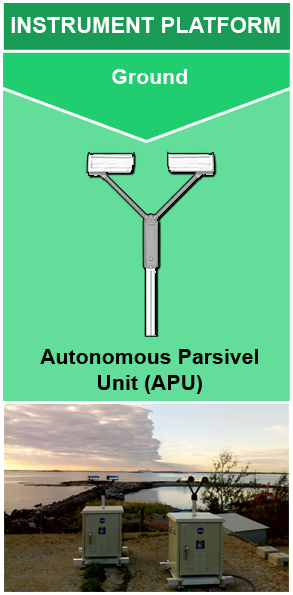Instrument: Autonomous Parsivel Unit (APU)
The Autonomous Parsivel Unit (APU) is a laser-based optical disdrometer system that measures the size and velocity of falling precipitation particles, or hydrometeors. APU is composed of the Parsivel2 laser disdrometer and its data reporting system. A disdrometer is an instrument that takes in situ measurements of the drop size distribution (DSD) of precipitation (in situ indicating the measurements are taken on site, not remotely). The DSD describes the number of drops that fall into a range of different drop size classes.The Parsivel2 disdrometer consists of two measurement heads: a transmitter and receiver (Figure 1). The transmitter generates a flat, horizontal laser beam, or “sheet”, with a 650 nm wavelength, directed toward the receiver to create a 54 cm2 measurement area between them. The receiver then converts the received light energy into an electrical signal that can be recorded and analyzed. When a precipitation particle falls through the measurement area, it reduces the intensity of the transmitted laser signal that reaches the receiver. The degree by which this signal is reduced is proportional to the size of the precipitation particle. The duration of the signal reduction is used to derive the hydrometeor fall velocity.

APU sorts precipitation particles into 32 different size classes ranging from 0 to 25 mm diameter and 32 velocity classes ranging from 0 to 20 ms-1 fall velocity. The APU system uses this size and velocity information to identify the DSD, type, intensity, and amount of precipitation. APU can classify multiple precipitation types including drizzle, rain, snow, sleet, and hail. Precipitation observations from APU offer valuable information for use in flood warning systems, monitoring road conditions, and precipitation research for atmospheric modeling applications.
Measures precipitation size (mm) and fall velocity (ms-1). Determines the DSD, type (drizzle, rain, sleet, snow, hail), intensity, and amount of precipitation. APU can also derive the equivalent radar reflectivity and visibility. Inaccuracies can result from multiple hydrometeors passing through the APU measurement area simultaneously but the system is designed to reduce the likelihood of this occurrence. High winds and non-meteorological targets such as flying insects can produce erroneous data values as well; often yielding abnormal terminal fall velocity measurements. Data quality control techniques can be applied to remove these abnormal values. Velocity measurements are often compared to an expected hydrometeor fall velocity and then removed if they fall above or below the expected value by a certain amount.

| SPATIAL RESOLUTION | SPATIAL EXTENT | PEAK POWER | TEMPORAL RESOLUTION | ACCURACY | WAVELENGTH |
|---|---|---|---|---|---|
|
Particle size measuring range:
0.2 to 8 mm (liquid)
0.2 to 25 mm (solid)
|
Point | 0.2 mW | Per precipitation event |
± 1 size class (0.2 to 2 mm)
± 0.5 size class (>2 mm)
|
650 - 780 nm |
Jaffrain, J. & Berne, A. (2011). Experimental quantification of the sampling uncertainty associated with measurements from PARSIVEL Disdrometers. Journal of Hydrometeorology, 12, 352–370. https://doi.org/10.1175/2010JHM1244.1
OTT HydroMet. (2019). OTT Parsivel2 - Laser Weather Sensor. https://www.ott.com/en-us/products/meteorological-sensors-26/ott-parsivel2-laser-weather-sensor-2392/
Park, S., Kim, H., Ham, Y., & Jung, S. (2017). Comparative Evaluation of the OTT PARSIVEL2 Using a Collocated Two-Dimensional Video Disdrometer. Journal of Atmospheric and Oceanic Technology, 34, 2059-2082. https://doi.org/10.1175/JTECH-D-16-0256.1
Raupach, T. H. & Berne, A. (2015). Correction of raindrop size distributions measured by Parsivel disdrometers, using a two-dimensional video disdrometer as a reference. Atmospheric Measurement Techniques, 8, 343-365. https://doi.org/10.5194/amt-8-343-2015
Tokay, A., Wolff, D. B., & Petersen, W. A. (2014). Evaluation of the New Version of the Laser-Optical Disdrometer, OTT Parsivel2. Journal of Atmospheric and Oceanic Technology, 31, 1276-1288. https://doi.org/10.1175/JTECH-D-13-00174.1









